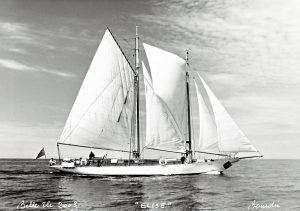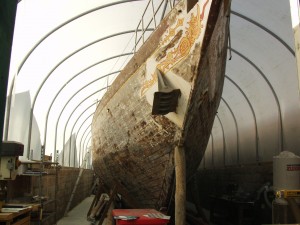
“A much loved family yacht” is right up there alongside, “The day dawned clear and cold…” as possibly the most clichéd phrase with which to commence any piece regarding classic yachts, or any yacht… But you may be required to park your prejudices for a while, because the amount of adoration that has been lavished for the last two decades on the 1912 William Fife III schooner Elise by the Meredith family, sets the bar for filial affection at a whole new level.

It was husband and wife, father and mother, now grandfather and grandmother, Ted and Bridget that started it all off for the Merediths when the couple bought the distinctive and elegant schooner back in 1992. The couple, who owned and still own a commercial ornamental garden plant nursery in Gloucestershire, sailed a Robert Clarke 8-Metre, Kalistra, out of the Devon harbour of Salcombe, and had much-admired the clipper-bowed, counter-sterned two-master on her moorings as they had gone about their travels (see following history for how she got there).
They kept a weather-eye on her for several years as the retired baker, Mr Appleyard – who had himself sailed the then dilapidated yacht into Salcombe Harbour in 1980 – attempted to rebuild the historic yacht on her mooring. For all his constant hard work, though, Mr Appleyard barely managed to stave off the ravages of time before, eventually, time caught up with the baker and, still far from completion, the yacht came up for sale. The adventurous streak that seems to permeate the Meredith line led Ted and Bridget to purchase the boat with the idea of rapidly finishing her restoration and then running her for charter. Even more adventurously, the couple decided that the best way to guarantee the rebuild project would progress at the required pace was to buy a half share in the local boat yard, Penwill Boatbuilders.

No small amount of travail was involved, even in getting Elise into Penwill’s yard, which required the tortuous navigation of a channel that was shallow enough to walk across at low tide, as well as the lengthy construction of a brand new concrete slipway. Once at the yard, though, things did not get much easier as the shed could not house the entire hull, so for the duration of the project, any interested Salcombe local could easily keep tabs on progress as they passed-by. As with so many projects, what was initially intended as something of a simple re-fit ballooned as it progressed.
The first step: to remove and replace the interior, led to the discovery and removal of suspect deck beams, which in turn led to the replacement of the entire deck. Working forward, it was then discovered that the stem was rotted and a whole new section was re-constructed from a grown oak baulk of timber, while at the same time many of the hood-ends were also replaced.

The work unearthed and undertaken was major but not mind-blowing for shipwright Dave Penwill, who commented at the time, with wonderful nonchalance: “Wooden boats are basically just a big kit. You take them apart and fix them.” Seeing the boat held together by nothing but steel hawsers and timber braces, with a gaping stem and no deck was perhaps a little more troubling for the new owners however hands-on they intended to be. And hands-on they were, not least son, Peter, who went on to become a professional skipper, shipwright and qualified naval architect and surveyor, learning many of his skills while assisting Dave Penwill on Elise’s rebuild.
Eventually, though, the time came to address the interior layout – initially, the main driving force for the plan to refit – so as to be able to run the vessel as a charter operation. The interior that was installed then is the one that she has today and has coped well with the demands placed upon her since. Any plans for accommodation aboard Elise will always somewhat be limited by her narrow beam (just 12ft 6in) combined with her long ends (63ft on deck, 45ft on the water), though her box-like mid-section, augmented by Fife’s voluminous skylights and deck piercings, allows for plenty of headroom (7ft-plus) and light throughout the accommodation section.

The solution arrived at by the Merediths suits perfectly their intentions as well as allowing the vessel to be rated at the highest category, Cat Zero, by the MCA. Berths are available for six guests plus two crew; with the majority of the rest of the interior being taken up by a large, virtually commercial-spec, galley and the capacious saloon that allows a full complement to be entertained in a manner befitting life aboard a distinguished Edwardian yacht.
Following her re-launch in 1996, Elise’s charter career proved to be a successful one, the Meredith’s managing to combine gathering enough paying custom from cruises out from Salcombe, to France, Scotland, the Med and the Caribbean to make her pay for herself, while they got to enjoy much time aboard for themselves and all the family.

All the major festivals were attended, weddings were conducted aboard and many miles were put under her keel by a continuous stream of happy guests. The growing family would fly out to meet the yacht wherever she may be, taking time aboard for themselves. That the Meredith’s entire extended family – amounting to some 40-odd members – was able to enjoy a life at sea in some of the world’s premier destinations aboard Elise must surely be one of the greatest perks of the charter business.
However, this happy continuum was brought to an abrupt end in January 2010. Ted and Bridget happened to be abroad at the time, and when the home phone rang it was answered by Peter. On the other end of the line a voice announced, with admirable Gallic insouciance: “Your yacht’s masts are the only things in the atmosphere.” – Elise had sunk on her moorings in Douarnenez harbour. After relaying a revised version of the bad news to his parents in the Falkland Islands, Pete was tasked with sorting out getting her back fully into her correct element.

Raising a yacht the size of Elise is no small matter and the salvage situation, not least, required careful consideration. In the end, a sum was negotiated with a local diving contractor and, with many nervously interested parties on hand, including representatives from the insurers, the maintenance shipyard and even, somewhat bizarrely, the local mayor, the boat was once again brought to the surface. The shipyard representative immediately unearthed the cause of the sinking as the premature failure of a cockpit drain cock.
Though the cause might be rectified at a cost of a few pounds, the damage throughout the boat was severe. The electronics required complete replacement, the leather-clad cushions and wooden panelling of the interior would need much work to resurrect to their former glory, not to mention replacement of the engine, ancillaries and much else – in insurance terms she was a write-off and future charters would have to be indefinitely postponed.

Once the insurance situation was sorted out, the yacht was repatriated to the UK where she has been installed within a purpose-built shed at the family business premises ever since. Today she sits, her hull stabilised and partially stripped, safely cosseted in her own dedicated shed surrounded by the trappings of her working past.
But now, on the threshold of her second century, the much loved family yacht needs a new home and perhaps a new family looking for adventure. The rebuilding work of the 1990s still stands good as does the knowledge that just a couple of years ago she was able to operate as a successful and respected charter yacht. With the interior in need of major refurbishment at the very least, this could be seen as a chance to mould a rare and desireable William Fife III schooner to exactly suit the personal desires of a new owner.
Elise is for sale through Sandeman Yacht Company. A detailed analysis and costing of the work required to put Elise back afloat has been carried out and is available on request, as is all the documentation and research generated by her 1992 rebuild.
